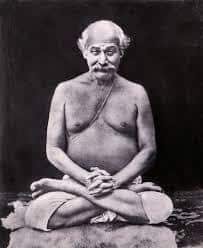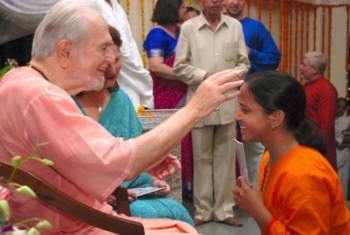
A reasonable question, certainly. The masters themselves, however, have said it should not be published precisely because it is a teaching that transcends reason itself. Right understanding of it depends on the unfolding intuition.
Kriya Yoga, in order to be wholly effective, must be received not only intellectually (in written or spoken form), but vibrationally, in the form of initiation. A magnet is created either by electrical realignment of the molecules, or by close proximity to another magnet. Attunement with a God-awakened guru influences the samskaras (comparable to the material molecules) to flow upward to the brain.
We are dealing here with a reality subtler, and much more difficult to master, than mere metallic molecules. Without an experienced guide, even mountain climbing can be fatal—though death, in this case, only ends a single incarnation. Spiritual mistakes can be costlier in terms of long-range suffering.
Guidance from the guru is not only helpful: It is essential. This does not mean that Kriya Yoga is dangerous. Far from it. But to take up Kriya Yoga signifies entering seriously onto the path to God. It is not a game, and should certainly be treated as a lifetime commitment…Any yoga initiation, and especially into the ancient science of Kriya Yoga, should be looked upon as a very sacred step in one’s life.
(Swami Kriyananda in The Essence of the Bhagavad Gita, Explained by Paramhansa Yogananda, As Remembered by His Disciple Swami Kriyananda)
 Kriya is a deceptively simple term that refers to a wide variety of practices. The Sanskrit word literally means action. The same Sanskrit root verb kri (to act) is also foun in the word karma. Whereas karma is generally understood as “actions that stem from egoic desire”, Kriya is understood to mean “actions that purify”.
In the science of Hatha Yoga there are many Kriyas that have the purpose of purifying the body and nervous system—for example, cleansing of the nose, the stomach, the intestines, the nerve channels, and so forth.
In the science of Raja Yoga, however, the term Kriya refers to practices that purify at the higher level of the ego. Thus they prevent future karma and also neutralize the “seeds” or traces of past karma from the consciousness.
When Babaji revived the ancient techniques for God-realisation that had been part of Raja Yoga in the higher ages, he called these practices by the name Kriya Yoga. This science includes a significant number of techniques that his disciple Lahiri Mahasaya focalised into a progression of preparatory exercises and initiations known as “the Kriya Yoga of Lahiri Mahasaya of Benares”.
Because of this great contribution, Lahiri Mahasaya is known as the father of Kriya Yoga in modern times, and as a yogavatar.
Lahiri Mahasaya initiated thousands of students into these practices, and to some of them he gave authority to initiate others. Many of these initiates have in turn initiated others. Various lines of Kriya have developed through succeeding generations. Thus from the tree of the Kriya of Lahiri Mahasaya many branches have grown. All the Kriya lines that come from Lahiri Mahasaya essentially teach the same techniques with some variations.
The Kriya that has come to the Western world through Paramhansa Yogananda, and that is also being taught today in the East by his disciple Swami Kriyananda, is one of the branches that comes through Lahiri Mahasaya’s disciple Swami Sri Yukteswar.
The word Kriya, being a generic term that refers to many practices of Raja and Hatha Yoga, is used today by many teachers to refer to practices similar but distinct from those taught by Lahiri Mahasaya. Searching the Internet will bring up thousands of references.
Kriya is a deceptively simple term that refers to a wide variety of practices. The Sanskrit word literally means action. The same Sanskrit root verb kri (to act) is also foun in the word karma. Whereas karma is generally understood as “actions that stem from egoic desire”, Kriya is understood to mean “actions that purify”.
In the science of Hatha Yoga there are many Kriyas that have the purpose of purifying the body and nervous system—for example, cleansing of the nose, the stomach, the intestines, the nerve channels, and so forth.
In the science of Raja Yoga, however, the term Kriya refers to practices that purify at the higher level of the ego. Thus they prevent future karma and also neutralize the “seeds” or traces of past karma from the consciousness.
When Babaji revived the ancient techniques for God-realisation that had been part of Raja Yoga in the higher ages, he called these practices by the name Kriya Yoga. This science includes a significant number of techniques that his disciple Lahiri Mahasaya focalised into a progression of preparatory exercises and initiations known as “the Kriya Yoga of Lahiri Mahasaya of Benares”.
Because of this great contribution, Lahiri Mahasaya is known as the father of Kriya Yoga in modern times, and as a yogavatar.
Lahiri Mahasaya initiated thousands of students into these practices, and to some of them he gave authority to initiate others. Many of these initiates have in turn initiated others. Various lines of Kriya have developed through succeeding generations. Thus from the tree of the Kriya of Lahiri Mahasaya many branches have grown. All the Kriya lines that come from Lahiri Mahasaya essentially teach the same techniques with some variations.
The Kriya that has come to the Western world through Paramhansa Yogananda, and that is also being taught today in the East by his disciple Swami Kriyananda, is one of the branches that comes through Lahiri Mahasaya’s disciple Swami Sri Yukteswar.
The word Kriya, being a generic term that refers to many practices of Raja and Hatha Yoga, is used today by many teachers to refer to practices similar but distinct from those taught by Lahiri Mahasaya. Searching the Internet will bring up thousands of references.When this question was posed to an advanced Kriya yogini in India, she replied, “The one your guru gives you”.
It is not the technique in itself that automatically leads to liberation, although its proper practice brings beneficial results to those who use it. Its proper practice, however, is possible only through the blessings of the guru, who uses the technique as an instrument of liberation for his disciples. As Yoganandaji used to say, “Kriya plus devotion works like mathematics”.
“The law of Kriya Yoga is eternal. It is true like mathematics;like the simple rules of addition and subtraction, the law of Kriya can never be destroyed. Burn to ashes all the books on mathematics, the logically-minded will always rediscover such truths; destroy all the sacred books on yoga, its fundamental laws will come out whenever there appears a true yogi who comprises within himself pure devotion and consequently pure knowledge.“
—Paramhansa Yogananda, Autobiography of a Yogi, 1946 Original Edition
Because of the necessity of the Guru’s blessings, the Kriya which stems from Babaji is given as an “initiation”, a ceremony during which the power and the blessings of the guru are transferred to the disciple to enable him to properly practice the technique.
The one who is yours; the one to whom you belong.
Among Self-realized masters, there is no competition. Each of them has been given by God certain souls to guide. Thus it is neither the guru who chooses his disciples, nor the disciple who chooses his guru. This is the true “marriage made in heaven”; two souls whom God has joined together until death (of the ego of the disciple) parts them and the disciple merges back into the cosmic ocean of consciousness.
The guru will make himself known to his disciples at that moment in their lives when they are ready to perceive and receive him. In one way or another they draw their disciples.
The ways are as many and varied as the disciples:y seeing the master in person, or through reading his written words, such as the Autobiography of a Yogi, into every word of which Yoganandaji said he had infused his vibrations.
- Through the spiritual practices that the master teaches.
- Through the magnetism of the fellowship of the master’s disciples, or at least those who carry their vibrations and message to others.
- Through the master’s spiritual work, which attracts those who are in tune with him.
- In dreams or visions of the master, by hearing his voice, or by seeing his photograph.
 The important thing for you as an aspiring disciple is to put yourself in tune with the vibrations of a master, using all means available to you, then feeling inwardly for a response in your heart. The response can manifest as deep love, joy, or the simple awareness that you have found your home.
The important thing for you as an aspiring disciple is to put yourself in tune with the vibrations of a master, using all means available to you, then feeling inwardly for a response in your heart. The response can manifest as deep love, joy, or the simple awareness that you have found your home.
No. Lahiri Mahasaya initiated people from all faiths as well as no faith into Kriya Yoga, saying that no one need give up his religion in order to follow this path.
“A significant feature of Lahiri Mahasaya’s life was his gift of Kriya initiation to those of every faith. Not Hindus only, but Moslems and Christians were among his foremost disciples. Monists and dualists, those of all faiths or of no established faith, were impartially received and instructed by the universal guru. [He] encouraged his various students to adhere to the good traditional discipline of their own faith. Stressing the all-inclusive nature of Kriya as a practical technique of liberation, Lahiri Mahasaya then gave his chelas liberty to express their lives in conformance with environment and upbringing.”
—Paramhansa Yogananda, Autobiography of a Yogi, 1946 Original Edition
Yes. Kriya is given as an initiation in a ceremonial setting to emphasize its significance as a sacrament, or sacred moment during which the transforming power of the guru is transferred to the disciple, enabling him to fully understand and deeply practice the liberating technique.
Such an advanced technique is not offered to those who wish to follow the teachings in their own way but to those who are willing and prepared to practice them as the guru instructs. With these attitudes of willingness, openness, and humility on the disciple’s part, the guru is able to give more than to one who is merely curious about the teachings.
<em>”Spiritual progress without the help of a true, or sat, guru, cannot but be slow, haphazard, uncertain, and sometimes dangerous. The ancient tradition in India, where spirituality has been studied for thousands of years—not as a religion, but as a practical science (“practical” in the sense of results actually accomplished)—has always insisted that a true guru is the sine qua non for success on the spiritual path. Many spiritually ignorant people, even in India, insist that with literacy as widespread as it is now, and with books so easily available, spiritual teachings are accessible to virtually everyone and a guru is no longer needed. Truly, widespread literacy has had one unfortunate effect: the dissemination, not only of knowledge, but of ignorance!
True understanding comes not by intellectual reasoning, but by intuition. Inner, intuitive attunement with the consciousness of the guru is what most surely and directly brings spiritual awakening.”</em>
—Swami Kriyananda in <em>The Essence of the Bhagavad Gita, Explained by Paramhansa Yogananda, As Remembered by His Disciple Swami Kriyananda</em>
In some cases this may be possible. You would need to talk with one of our Kriyacharyas.
We would be happy to help you with your practice if possible and would need to speak with you personally to see if Kriya initiation through Ananda Sangha would be appropriate.
You are affirming your discipleship to God, Yogananda, and the line of Kriya masters of our path, and committing yourself to practicing the Kriya techniques faithfully as they are taught to you, and regularly—at least twice each day. You also promise never to reveal the Kriya techniques to anyone unless given authorisation to do so.
Yoganandaji has given preparatory practices that can be used by everyone in daily life: the Energisation Exercises and the Hong-Sau technique of concentration. Practicing them—along with studying the writings of Yoganandaji and Kriyanandaji and coming whenever possible to an Ananda teaching centre to participate in courses on the path of Kriya—will be greatly beneficial.
As you use the principles and do the practices, you will begin to have your own relationship with the gurus and your own experience of the benefits that the techniques bring to your consciousness, your inner state of well-being, and your daily life.
To help you know if the Kriya path and masters are right for you, why not try including them in every aspect of your life and see how it feels?
It is not a matter of letting time pass but of engaging yourself in the daily practice of the basic techniques on the path of Kriya. You need to dedicate at least forty-five minutes twice a day to your practice.
After about six months, once you have established a solid daily routine, you would be eligible for discipleship initiation and advanced techniques to prepare for Kriya Yoga initiation. After practicing those for several months more, you would be eligible to request initiation into Kriya Yoga.
For Kriya Yoga initiation, you need time to establish a regular, consistent meditation routine.
You also need time to gain understanding of and attunement with the path of Kriya Yoga and the channels through which it comes.
Lastly, Yoganandaji also recommended that in order to practice Kriya Yoga properly, the nervous system must be prepared.
On the path of Kriya Yoga as taught in the line of Lahiri Mahasaya, there are four.
When you have been meditating regularly with the basic Kriya technique for several years and feel ready to increase your meditation time, you can request permission to receive higher Kriya preparation and initiation into the advanced Kriyas.
Yes. Kriya initiations are given in person several times each year at Ananda Sangha in Gurgaon. You are also welcome to attend one of our Kriya Yoga initiations in Mumbai, Bangalore, Pune, Hyderabad, Kolkata, and elsewhere. The initiations are performed by Kriyacharyas who have been authorised by Swami Kriyananda.
Come, if you can, to all the initiation ceremonies, especially those in the first year!
The blessings we receive during Kriya ceremonies help us enormously in our spiritual progress. And at each initiation, we are able to understand the practices more deeply.


